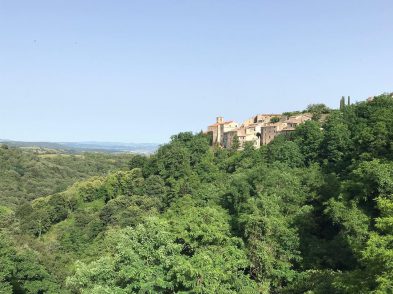It’s a beautiful spring afternoon in southern Tuscany, and we are once more on a mad rush into the woods. While locals and tourists alike are preparing to stroll the streets of Florence or Rome, we’re donning our thickest boots and giving our neighbours dirty looks as we slowly slink away to fare una passeggiata (go for a walk). No thanks for the offer, but we don’t want any company.
It’s not mushroom season and we certainly aren’t looking for truffles. The hunting season is closed, so you can’t beat us to the wild boar or pheasant. It’s too early for snails and there aren’t any wild berries, but in the great resourceful tradition of country Tuscans, we will always find something wild to eat that we don’t want you to get to first.

Wild asparagus run rampant in countryside Tuscany from late February until the end of May. They grow anywhere there’s a cluster of trees or open field that hasn’t been cultivated in a while, and you don’t need a gun, license or closely guarded knowledge of fruitful foraging spots to join in. It’s as easy as stopping on the side of a country road and wandering a few metres into the brush.
When you stumble across a particularly big group of wild asparagus, it’s called an asparagiaia. Every astute local knows where one is and guards it with his or her life. It doesn’t matter that wild asparagus are almost as common as blades of grass in spring or that they have none of the commercial value of porcini mushrooms or truffles. Country Tuscans are inherently cagey when foraging and no amount of asparagus-filled baskets are ever enough.
As with all wild fare, hunting for asparagus can be traced back to the days when locals would supplement their diet during poor harvest or vast stretches of poverty with whatever they could find in the woods. Modern country Tuscans aren’t starving, but many still spend almost every spring Sunday keeping the tradition alive. My father-in-law is an asparagus hound and I never miss a hunt.
It reminds me of the stories my mother would tell of Italian immigrants picking wild chestnuts or rocket on the roadsides in Australia. It was something they did well into the 1980s, until both became prized culinary ingredients.
Wild asparagus are impossible to confuse with anything else, so you don’t have to worry about picking a poisonous weed by mistake. They are, however, completely different from their farmed cousins. Rather than thick woody shoots, wild asparagus are as thin a pen. When you find one, you find a hundred as they grow in thick, bright green clusters. To pick them, use a pair of scissors or just break them off with your fingers as you would parsley. Wild asparagus benefit from being picked and will come back in the same spot even thicker and more content the following year.
The only thing an asparagus hunter needs to be aware of is private property. In other words, don’t be inspired by the locals and slip under wire fencing when you think the owner isn’t looking. It’s also a good idea to wear closed shoes because wild asparagus naturally pop up in places that aren’t regularly cultivated and, while rare, snakes do, too.

Burdened by your basket of asparagus, snap off the woody ends and eat them raw. Once home, quickly blanch them, like the locals do. The time spent in the boiling water takes away any bitterness and helps to soften stringy bits.
A favourite local recipe is to toss the blanched asparagus with olive oil, salt and pepper and mix into cooked pasta with a healthy dose of parmesan. With a generous amount of parmesan and a touch of cream to finish, wild asparagus also make a beautiful spring risotto.
But most of those who hunt wild asparagus like to keep things simple so as not to overwhelm the vegetable’s delicate flavour. Slice the stalks thinly, beat an egg or two with a splash of milk and some light seasoning, and prepare a quick, easy and delicious omelette.
As with all Tuscan traditions, the nonnas have a word of warning: be careful not to eat too many wild asparagus or you could damage your kidneys. This might just be an old wives’ tale, but it’s something the locals swear by. Happy hunting!








